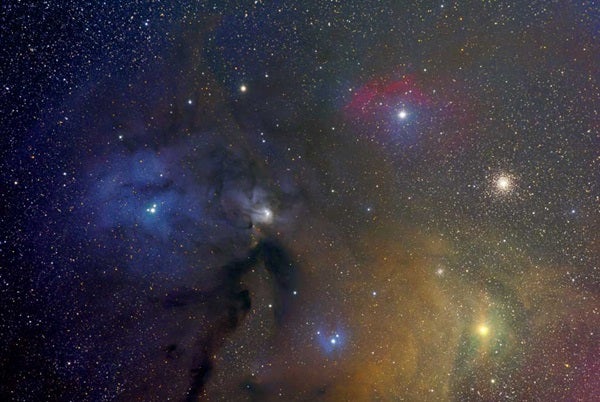I never thought such a sight was possible until I chanced upon these dim mists in a comet sweep July 29, 2003. At a distance of nearly 450 light-years, this mesh of dark nebulae spread across several degrees of sky is one of the closest star-forming regions to the Sun.
In contrast, the bright nebulae superimposed on the complex create a cruciform pattern about 1° northwest of Antares.
Three bright stars in Scorpius and one in Ophiuchus — Antares to the south, Rho Oph to the north, and 22 and Sigma (σ) Scorpii to the east and west, respectively — cause the nebulae’s radiance. These gaseous glows occupy space within a void that the German-born British observer William Herschel referred to as a “hole in the heavens” when he first observed it. William’s son, John Herschel, also investigated these regions of space “through which we seem to gaze into an uninterrupted infinity” in his 1847 Observations at the Cape of Good Hope.
American astronomer Edward Emerson Barnard, however, was first to encounter the bright mists occupying the vacancy. In an article published in 1897 in Popular Astronomy, Barnard wrote: “For many years this part of the sky troubled me every time I swept over it in my comet seeking, though there seemed to be scarcely any stars here. There yet appeared a dullness of the field as if the sky were covered with a thin veiling of dust, that took away the rich blackness peculiar to many vacant regions of the heavens.”
The visual “Cloud Nebula”
The nebulosity inherent in Rho Oph is amazing. The breathtaking landscape of visual textures is unparalleled — at least in photographs. Be warned, though: These translucent vapors lie at the threshold of visibility in a 4-inch telescope.
But the most spectacular features (which are visible even through binoculars) are two long, lusterless lanes of dark nebulosity. These filaments stretch 10° to 20° eastward from Rho Oph.
With the unaided eye, you can see the globular cluster M4 and the fainter, yet still beautiful, globular NGC 6144, four times farther away. Both punctuate the scene near Antares.
The brightest region is IC 4604, which surrounds two 7th-magnitude stars just northwest of 5th-magnitude Rho. Larry Mitchell, of Houston, and I viewed this 10′-wide patch of pale light through 10×50 binoculars (with effort) from Mauna Kea, Hawaii. Telescopically, the nebula is dumbbell-shaped with adorning knots and rays.
The next obvious region, IC 4605, is in itself a cruciform-shaped glow. Each point of the cross resembles a candle flame blowing in the wind.
The textures are difficult to fathom in a wide-field view, so accumulate an impression during sweeps. When observing IC 4605, avert your gaze and scan at a steady pace. Sweep back and forth across the region several times. The more you do this, the more textures should appear.
I never would have imagined that faint nebulosities (both luminous and dark) could have so many degrees of haziness. You can appreciate the Rho Oph complex only under very dark skies, but I wanted to share the view with you because light pollution threatens to make all of this detail a modern-day myth. If you are able to observe this region, send your impressions to someara@interpac.net.











